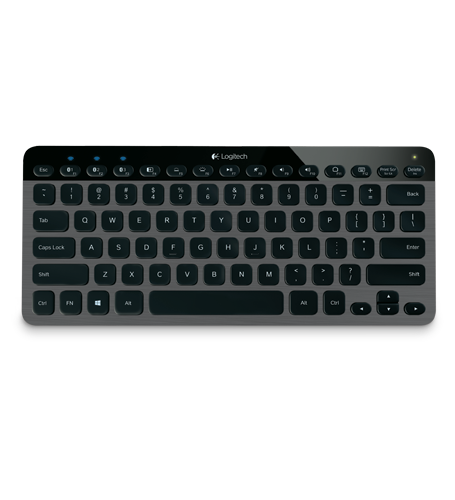
I’m a little surprised that I’m actually writing a post about a keyboard. I love toys and gadgets just as much as anyone, but really? A keyboard? Well the Logitech K810 is surprisingly good. In fact it kind of makes working fun.
I bought mine from Amazon.com
My Setup
I use 2 computers at work – both Mac and Windows. In recent years I’ve gravitated to using the Mac more often mainly because everything is so ergonomically beautiful. For my own personal taste – the Apple keyboards are simple and a joy to use. My old clacky Dell keyboard was slowly becoming more and more frustrating to use simply because it was extremely uncomfortable. Writing long documents, posts or even putting together presentation outlines was a beating.
I use both Mac and Windows for several reasons and I’m comfortable switching back and forth. I’d really stopped using my Windows machine for anything but work email. I realized this was not a good productive use of time or equipment so I decided to switch out a few things. Really what I wanted was my Apple bluetooth keyboard to work on my PC. There are some ways to hack this to make it work, but I 1) didn’t want to spend time hacking something together and 2) I need everything to work. There are some fundamental OS differences between Windows and Mac OSX so you really have to have a dedicated keyboard to make things work right.
I ended up deciding on Logitech simply because I was familiar with some of the things they made for Apple products and I figured this would be my best bet in getting the ergonomic Apple experience over on the Windows side of things. I couldn’t be happier with this choice.
The Logitech K810
First I should say this is not the cheapest keyboard you can get. Lets get this out of the way first – cheap keyboards feel cheap. You get what you pay for. The Logitech K810 is not crazy expensive, but its probably a little more than you’d expect to pay. Its worth it. Get price out of your head – this is a well priced keyboard. Here’s why:
1) Build Quality
This is a very solid keyboard. Not all of Logitech’s products are like this, I know. Some of them – even expensive stuff – can sometimes feel cheap and plastic-like. This one is not. Its beautifully designed with a brushed metal texture against a black glass looking base. Very well done. Lightweight if you need to travel with it – its really a beautiful design with a solid feel to it.
2) Ergonomics
If Apple keyboards are your thing, you’ll be right at home on this. I know this feel isn’t for everyone. I don’t need to man-handle a keyboard and I was looking for something that would feel like the Apple Bluetooth keyboard. Quite simply, this is it.
3) Bluetooth
This was a big deal for me too. I’m tired of wires everywhere so I needed Bluetooth capability. The keyboard does require at least a Bluetooth-USB plug if your PC doesn’t naively support Bluetooth. I got one and the set up was easy and seamless. Surprising since its Window’s we’re talking about here ;-)
4) Battery Life
I’ve only been on this keyboard a short time, but time will tell. The manual boasts a 3 hour charge time (using the included micro USB cable). Once charged you reportedly get 3 weeks of illuminated typing and a year of non-illumined off of the built in battery. This is really nice as I hate changing the AA batteries that my Apple keyboard takes. In fact, this might even be better than my Apple keyboard in a few regards. I’m not used to this in the Windows world.
5) Illuminated Keyboard
Works just like the Apple laptop keyboards. It senses how bright the room is and if its dim, it kicks in the back-lit, illuminated keys. Beautiful.
6) Switching Capability
Here’s what I didn’t expect. There are 3 Bluetooth keys on the top, left of the keyboard. You can set these up for device switching. The keyboard supports Windows PC’s, iOS devices and Android based devices. This is amazing. I’m typing along and get a text message on my iPhone… I hit the “2” switch on the top of the keyboard and I’m now typing to my iPhone. I hit send and switch back to the PC without missing a beat. It would be nice to have a keyboard that supported both Mac and PC so I could just use one keyboard for both setups. I know that’s tough to do, but it would make this the ultimate keyboard period for both platforms. Also I really would like to be able to cut and paste across devices. I know this is an OS thing and would require the keyboard itself to have memory inside, but it would be awesome. That’s the problem when you have a device like this, you start dreaming of the possibilities. Its amazing.
7) Overall Impression
I give this a full 5 stars. It fulfilled everything I needed for my Windows PC and has made it a pleasure to use again. Its ergonomic, the desk footprint is tiny and its a joy to use. I didn’t realize this offered USB switching when I ordered it – so that was a huge bonus and surprise.
So get the Logitech K810 – you won’t be disappointed.
 Thanks for checking out the website! FocusingWork.com is a blog where I explore things related to working efficiently and building a business.
Thanks for checking out the website! FocusingWork.com is a blog where I explore things related to working efficiently and building a business. 










